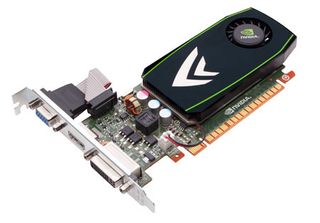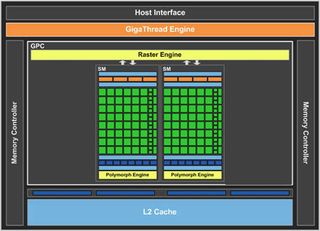GeForce GT 430: The HTPC Crowd Gets Fermi On A Diet
After addressing mainstream gamers with the GF106-based GeForce GTS 450, Nvidia is nudging a new GPU into the desktop space, built onto a card seemingly tailor-made for HTPCs. Does the new $79 GeForce GT 430 taste great, or is it just less filling?

GeForce GT 430 Specifications
The GeForce GTX 480 launch gave Nvidia the right to claim it sold the fastest GPU on the market. Oddly enough, that crown has never meant less than it does now. While Nvidia’s monolithic GF100 graphics processor boasts the ultimate in single-GPU performance, gamers are much more accepting of lower power, lower cost, and high-performance alternatives like the GeForce GTX 460 in SLI and AMD's Radeon HD 5850.
The good news is that Nvidia is back in the game, thanks to a handful of price cuts and derivative versions of that original GF100 processor. With the introduction of GeForce GTX 460, we saw a smaller, more efficient Fermi-based graphics processor (GF104) at the $200 price point. Next came the GeForce GTS 450, sporting the GF104-derived GF106 GPU. This brought Nvidia’s DirectX 11 lineup all the way down to $130.
But with no new graphics card under that decidedly mainstream $130 price point, Nvidia continues to fight for sub-$100 sales with products fundamentally based on the GeForce 8000-series, which was released back in 2006.
That is, until now. Enter the GeForce GT 430.

The GPU driving Nvidia's GeForce GT 430 is nothing new to the notebook world. Its GF108 GPU has already been released in a number of notebook graphics adapters: the GeForce GT 435M, 425M, 420M, and 415M all use this piece of silicon. The GeForce GT 430 is the first desktop-oriented SKU employing the GF108, though, just as the GeForce GTS 450 is the first desktop graphics card armed with GF106. Let’s have a closer look at the GF108 GPU:

This GPU has a single Graphics Processing Cluster (GPC) with two Streaming Multiprocessors (SMs). Each SM is identical to the ones found in the GeForce GTX 460 and GeForce GTS 450, with 48 shader cores, eight texture units, four dispatch units, and a Polymorph engine.
The render back-end has two 64-bit memory controllers and a single ROP partition capable of four 32-bit pixels per clock. As a result, the GeForce GT 430 is essentially half of the GeForce GTS 450, but with half of the ROPs and the same 128-bit memory bus as the more expensive model. The result is a GPU with 96 shader cores, 16 texture units, and four ROPs.
Stay on the Cutting Edge
Join the experts who read Tom's Hardware for the inside track on enthusiast PC tech news — and have for over 25 years. We'll send breaking news and in-depth reviews of CPUs, GPUs, AI, maker hardware and more straight to your inbox.
With this information in hand, let’s compare the new GeForce GT 430 with the other ponies in Nvidia’s sub-$100 stable:
| Header Cell - Column 0 | GeForce GT 220 | GeForce GT 430 | GeForce GT 240 |
|---|---|---|---|
| Shader Cores: | 48 | 96 | 96 |
| Texture Units: | 16 | 16 | 32 |
| Color ROPs: | 8 | 4 | 8 |
| Fabrication process: | 40 nm | 40 nm | 40 nm |
| Core/Shader Clock: | 625/1360 MHz | 700/1400 MHz | 550/1340 MHz |
| Memory Clock: | 790 MHz DDR3 | 900 MHz DDR3 | 850 MHz GDDR5 |
| Memory Bus: | 128-bit | 128-bit | 128-bit |
| Memory Bandwidth: | 25.3 GB/s DDR3 | 28.8 GB/s DDR3 | 54.4 GB/s GDDR5 |
| Transistors (Millions): | 486 | 585 | 727 |
| Thermal Design Power (W) | 58 | 42.7 | 69 |
First, we need to mention that the MSRP for the new GeForce GT 430 is $79. With that in mind, let’s start by comparing the new GeForce GT 430 to the GeForce GT 220.
Nvidia suggests that the GeForce GT 430 will share the GeForce GT 220's price point, but the older card won't be end-of-lifed in the near future. Indeed, DDR3 versions of the GeForce GT 220 start at $75 on Newegg, so this is a fair comparison. From this perspective, the new GeForce GT 430 has an obvious advantage over its predecessor in the form of double the shader cores and a 75 MHz-higher core clock (despite the same number of texture units and half the ROPs).
Nvidia's own benchmark numbers indicate that the new card is often 50% faster that the GeForce GT 220. We’ll see if this is true in the benchmarks, but from a cursory glance at the raw specs, this seems feasible.
The GeForce GT 430’s real problem comes from the GeForce GT 240, however—particularly the GDDR5 version of the card. These can be found on Newegg for $79 too, and they hang a colossal memory bandwidth advantage over the DDR3-equipped GT 430's head. Now, it’s important to mention that the GF108 GPU is quite capable of working with GDDR5 memory and that a GDDR5-based variant is in the works. But the DDR3 version will be available first.
In any case, from a pure GPU performance standpoint, the older GeForce GT 240 has an identical number of shader cores as today's GeForce GT 430. The newer card has a 700/1400 MHz core/shader clock compared to the GT 240's 550/1360 MHz frequencies. The biggest difference is that Nvidia's GeForce GT 430 has half the texture units and ROPs as the GeForce GT 240. While it’s impossible to run an apples-to-apples test until the GDDR5 version of the GeForce GT 430 arrives, the reduced ROP count suggests that the new card has lower anti-aliased and high resolution performance potential, and the decreased number of texture mapping units results in a hit to textured fillrate.


To be fair, Nvidia is not positioning the GeForce GT 430 as a replacement for the GeForce GT 240. The new model is touted as a low-cost, low-power jack-of-all-trades; an ideal option for a home theatre PC. In this role, the GeForce GT 430 includes attractive features like DirectX 11 support and the ability to bitstream lossless DTS-HD Master Audio and Dolby TrueHD multi-channel audio. The result is a feature combination that no other sub-$100 card can offer: 3D Blu-ray playback, 3D Vision gaming (though the viability of this is debatable), and HD audio in a half-height HTPC-friendly package. CUDA and PhysX are included as well.
Of course, the GeForce GT 430 isn't only getting assailed by other GeForce cards. AMD's Radeon HD 5570 is another sub-$80 solution, and the Radeon HD 5670 can be found for $80, too. Both of these boards support HD audio via bitstreaming as well, and both at least support triple display outputs through Eyefinity, though it's up to board vendors to enable that value-add on their mainstream offerings. Of course, the Radeon HD 5670 brings much faster gaming performance to the table. On the other hand, none of the Radeon cards are capable of 1080p 3D Blu-ray playback or stereoscopic gaming (although the latter may be possible with 3rd party software and certain monitors).
Current page: GeForce GT 430 Specifications
Next Page Nvidia's Reference GeForce GT 430 And Asus’ ENGT430-
fausto Anybody use HTPC state side with a satallite/cable provider? cable card? are you able to decode OnDemand and Premium Channels in the United States?Reply
Because it seems like HTPC's primary options are services like Hulu and Netflix. -
cknobman Not impressed.....at all.Reply
Its not like Nvidia was racing AMD to the market here so I fail to see why they insist on pushing out a product that is not priced competitively.
Heck Nvidia's new product isnt even priced appropriately against their last generation cards much less AMDs year old offerings. -
christiangordon faustoAnybody use HTPC state side with a satallite/cable provider? cable card? are you able to decode OnDemand and Premium Channels in the United States?Because it seems like HTPC's primary options are services like Hulu and Netflix.Reply
I have used the HTPC cards and they don't work with Sat/ATT companies for OnDemand. They are basically good for 720p 1080p formats
-
rolli59 Slots in next to HD5570 low profile for small form factor cases with limited size PSU!Reply -
neilnh faustoAnybody use HTPC state side with a satallite/cable provider? cable card? are you able to decode OnDemand and Premium Channels in the United States?Because it seems like HTPC's primary options are services like Hulu and Netflix.Reply
I use my HTPC for OTA HD networks (Fox, ABC, NBC, etc), Hulu, ESPN3, Blu-ray, and DVD-rips. I get HD on most of the shows I watch, and Hulu doesn't look bad for the others. There are very few gaps, but some would care a lot about them... HBO, NFL network, ESPN content that isn't available on ESPN3. Overall though, no monthly fee for all my TV with HD DVR... I like it. Some people use cable cards, but my whole reason for going the HTPC route was to save money, not pay more. -
ikefu The only reason for this card is if you actually watch 3D Bluray, for anything else the 5670 seems way better.Reply
I have a 55" 3d TV but hate the glasses so much I can't ever see myself using 3D playback. I'd go for 5670 just for the occasional gaming session. -
Onus This just shows how good the HD5670 is. And, with GDDR5 versions of the HD5570 available, there's just no reason for this card at this price. Pass.Reply
Most Popular

